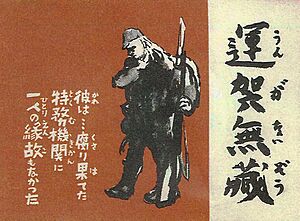Taro Yashima facts for kids
Quick facts for kids
Taro Yashima
|
|
|---|---|
| 八島 太郎 | |
| Born |
Atsushi Iwamatsu
September 21, 1908 |
| Died | June 30, 1994 (aged 85) |
| Occupation | Children's book author, artist |
| Spouse(s) | Mitsu Yashima |
| Children | Makoto Iwamatsu, Momo Yashima |
Taro Yashima (八島 太郎, Yashima Tarō, born Atsushi Iwamatsu (岩松 淳, Iwamatsu Atsushi); September 21, 1908 — June 30, 1994) was a Japanese-American artist and author of children's books. He moved to the United States in 1939. There, he helped with the U.S. war effort during World War II.
Contents
Taro Yashima's Early Life
Atsushi Iwamatsu was born on September 21, 1908, in Nejime, Japan. He grew up on the southern coast of Kyūshū. His father was a doctor who loved collecting art. He encouraged his son to pursue art as well.
After studying for three years at the Imperial Art Academy in Tokyo, Atsushi was asked to leave. This was because he did not follow rules and missed a military drill. He then joined a group of artists who supported regular workers. They were against the rise of Japanese militarism, which was when Japan's military became very powerful and controlled the government.
Many artists and other groups in Japan were against the military at this time. They made posters to protest Japan's actions in China. However, after Japan invaded Manchuria, the Japanese government started to stop people from speaking out. They used arrests and even torture by a special police force called the Tokkō.
Atsushi and his wife, Tomoe (who was pregnant), were held in prison. They faced harsh treatment because they were against the military government. In 1939, they left Japan for the United States. Atsushi wanted to avoid being forced into the Japanese Army and to study art. They had to leave their young son, Mako, behind.
After the Attack on Pearl Harbor, Atsushi joined the U.S. Army. He worked as an artist for the United States Office of War Information (OWI) and later for the Office of Strategic Services (OSS). This is when he started using the name Taro Yashima. He used this name because he worried about his son Mako and other family members in Japan. He feared they might be punished if the Japanese government knew he was working for the U.S.
After the war, the U.S. Congress allowed Taro and his wife to become permanent residents. Soon after, they had another child, Momo, in New York City. In 1949, Taro was able to return to Japan and bring Mako to live with them.
Becoming an Artist and Author
In 1943, Taro Yashima published a book called The New Sun. It was an autobiography for adults, meaning it told the story of his own life. The book described life in Japan before the war, when the government had a lot of control. It also shared details about the difficult treatment he and his wife faced for being part of anti-military groups in the 1930s.
His next book, Horizon is Calling, came out in 1947. It was similar, with one picture and a few lines of text on most pages. This 276-page book continued his life story in Japan under military rule. It also included Japanese text. In this book, Yashima wrote about the Tokkō police and how Japan was building up its industries for war in the 1930s. He also wrote about his respected teacher, "Mr. Isobe," who died after being forced into military service. A kind teacher with the same name also appears in his famous children's book, Crow Boy. The book ends with his thoughts about leaving Japan to study art abroad.
Taro Yashima started writing and illustrating books for children in the early 1950s. He used the same pen name, Taro Yashima, that he had used during the war. His children's book Crow Boy won the Children's Book Award in 1955. Other picture books like Crow Boy (1955), Umbrella (1958), and Seashore Story (1967) were all honored with the Caldecott Medal. This award is given by librarians to the illustrator of the best American picture book for children.
In 1963, Taro Yashima shared his thoughts on writing for children. He said, "Let children enjoy living on this earth, let children be strong enough not to be beaten or twisted by evil on this earth."
Taro Yashima later went back to his home village of Nejime. He visited old friends from childhood and saw familiar places that he drew in his children's books. In 1971, he worked with filmmaker Glenn Johnson to create a 26-minute documentary. It was called Taro Yashima's Golden Village and Yashima himself hosted and narrated it.
Books by Taro Yashima
- The New Sun (1943)
- Horizon is Calling (1947)
- The Village Tree (1953)
- Plenty to Watch (1954) by Mitsu and Taro Yashima
- Crow Boy (1955)
- Umbrella (1958)
- Momo's Kitten (1961) by Mitsu and Taro Yashima, illustrated by Taro Yashima
- Youngest One (1962)
- Seashore Story (1967)
Later Life and Family
In 1954, the Yashima family moved from New York to Los Angeles. There, they opened an art institute.
Taro Yashima was the father of two children. His son, Iwamatsu Makoto, became a well-known actor and voice actor. His daughter, Momo Yashima, also became an actress.
Taro Yashima passed away in Glendale Memorial Hospital in 1994.


